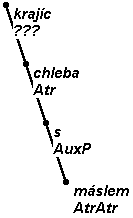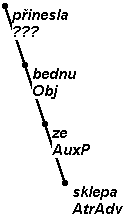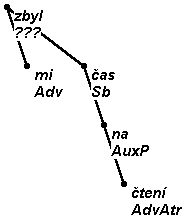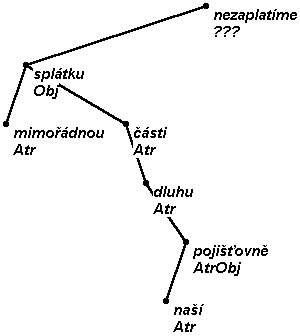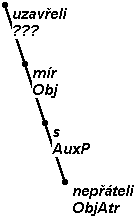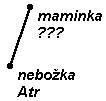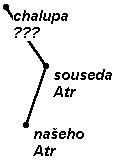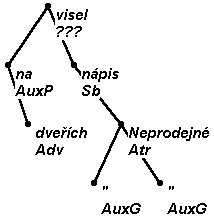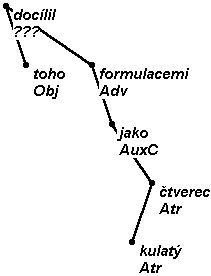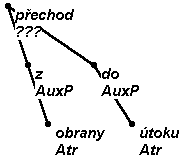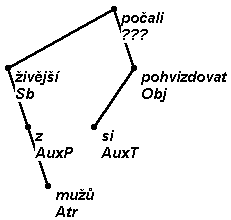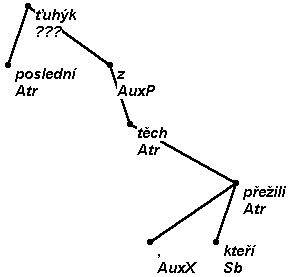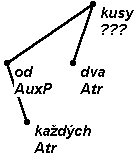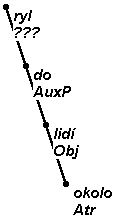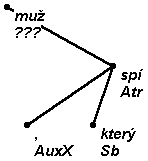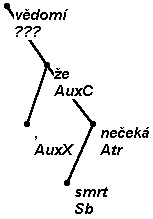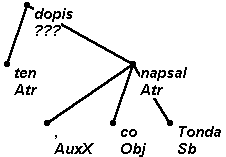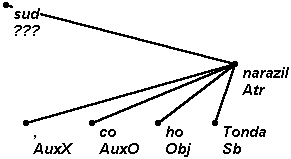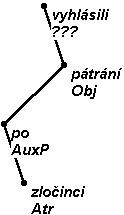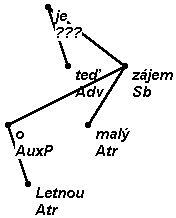This section is devoted to Attribute. First, in the part Defining Atr, it will be defined; we find that there are concordant and discordant (agreeing and non-agreeing) attributes, both being formally represented in the same manner on the analytical level.
We use more than one single function Atr for attribute: owing to a certain ambiguity we have had to introduce also the so-called combined functions: they are such "afuns" as AtrAtr, AtrAdv, AdvAtr, AtrObj and ObjAtr - all to be treated in the part Combined functions.
An extensive part Expression of Atr follows, concerning the ways of expression of attributes. An agreeing attribute is expressed by an adjective (Agreeing attribute expressed by an adjective) and less frequently by a noun (Agreeing attribute expressed by a noun). A non-agreeing attribute is usually expressed by a genitive of a noun (Non-agreeing attribute expressed by a genitive noun), but quite frequently also by some other simple case (Non-agreeing attribute expressed by a noun in another prepositionless case), a noun introduced by the conjunction jako (as, like) (Non-agreeing attribute expressed by a noun introduced by the conjunction jako (as, like)) or by a prepositional case (Non-agreeing attribute expressed by a noun in prepositional case). In specific cases, it can be expressed by an adverb, too (Non-agreeing attribute expressed by an adverb), and, with certain nouns, by an infinitive (Non-agreeing attribute expressed by infinitive). Apart from all these possibilities an attribute can be expressed by a subordinate clause (Attribute expressed by a subordinate clause).
At the end of this section, in the part Non-agreeing attribute in a non-projective position in the sentence, some points concern the problem of a non-projective position of the attribute in a sentence.
Attribute is a sentence member which depends on a noun in any of its sentential functions and which, as a rule, specifies more closely, or "determines" its meaning. In inquiring about attributes we use such interrogative pronouns as which, what or whose connected with the governing noun. Attribute either agrees with its governing member or it is governed by it, or its dependency is not expressed by a special form.
An attribute that agrees, at least in case, with the noun on which it depends, is called agreeing attribute. If this attribute is represented by an adjective (a pronoun or a numeral in this status) it agrees in case, number and gender. In rare cases there occur attributes of feminine gender pertaining to masculine nouns as a means of emotional expression, e.g., kluk ušatá - a long-eared-Fem urchin-Masc.
An attribute that does not decline in accordance with its governing noun and, as a rule, represents a case different from that of this noun, or is expressed by an adverb or an infinitive, is called a non-agreeing attribute.
An attribute can be expressed by a subordinate clause, introduced by a conjunction or by a relative pronoun. An attributive clause, however, cannot be seen in such a "pseudo-expansion" as, e.g., já viděl anděla a ten měl strašný štít (I saw an angel and he had a formidable shield), nor in clauses joined by expressions such as což, přičemž (what, at which), etc. These are interpreted as coordination of head clauses - see Coordination (sentential, of sentence parts) Coord, <afun> _Co (on což especially the part Coordination in sentences with což (which), přičemž (whilst)).
A descriptive (non-restrictive) attribute is separated by commas in the sentence (chovanci, umístění v ústavu, něco sebrali - the inmates, confined in the institute, have pinched something). Such an attribute obtains the function Atr, too (not Atr_Pa), as the case is not a parenthesis, for which it could be taken by mistake.
Afun Atr, however, can also be used in some instances in which the case is not a classical attribute. Thus, it can be obtained by parts of addresses or parts of the text in foreign languages. We can use it in analyzing numerical expressions as well. These problems are dealt with in Addresses and names of persons and institutions, Foreign words in the text, and Expression with numerals, figures in different functions.
In addition to Atr also combined "afuns" have been introduced, which consist of Atr and some other function. They are afuns AtrAtr, AtrAdv, AdvAtr, AtrObj, ObjAtr. These functions are used where the analyzed member (node) can stand in more functions in the framework of the given sentence without having its meaning substantially changed (the sentence is not strictly homonymous as far as the function of the analyzed member is concerned).
Therefore, if the node can constitute an attribute (Atr) of two or more nodes in the same branch of the tree above, we use afun AtrAtr. The node marked in this way will be suspended under the lowest node to be considered (it can fulfil the function of an attribute of that node). In the example given below the function AtrAtr will be assigned to the prepositional case s máslem (with butter). It obviously can form an attribute either to the member krajíc (slice) or to the member chleba (bread), while the meaning of the sentence remains essentially the same. It will, however, be suspended under the node chleba, since this modifies the node krajíc and, therefore, is situated lower in the branch.
The remaining four functions are intended for cases where some member can constitute an attribute (of one node or of more nodes as in the preceding case) and an adverbial (Adv) at the same time or an object (Obj) of a predicate placed above. Such a member then obtains an afun composed of the two basic ones pertaining to it. Which of the two components comes first and which of them second depends on which function it satisfies more often, which of them is more probable. This decision is difficult to describe in general terms, it will depend on the the annotator's attitude. If the annotator feels that a given member is rather an attribute, he will use the functions AtrAdv or AtrObj. Otherwise he will use one of the other two.
Whichever of the functions may be present, the given node will always be situated in the same position in the tree, namely in the position in which it would be placed as an attribute (Atr). It never depends directly from the predicate. In exceptional cases when in addition to the function Adv or Obj the given member would fulfil more functions of Atr (attribute in relation to more nodes), it will be suspended in the same way as in the case of afun AtrAtr, i.e. on the lowest situated one of all these nodes (cf. the example (3) below).
As a matter of fact, this is a substitute for adjectival forms of attributes, cf. E. ogre monster, Ajax Amsterdam, Miss neighbour etc.
In a collocation such as my Němci (we the Germans) the pronoun my (we) gets the position of the head and Němci (Germans) has the position of its attribute; agreement is ensured.
Possessive genitive, g. of property, explicative g., partitive g., g. of comparison, all fall within this category; so does, with deverbative nouns, g. of actor (of subject) and that of goal of action (of object). Problems could be connected with the representation of partitive genitive; this is dealt with in detail in Expression with numerals, figures in different functions
A non-agreeing attribute can also be expressed by a dative, an instrumental, an accusative or a nominative of naming. The nominative of naming is a specification of a governing word that is of a more general nature.
An attribute can be introduced by the conjunction jako (like). This expression of an attribute must not be mistaken for the comparative phrase with jako (e.g. with stejně jako similarly as, jako když as when, jako v+N as in+N), described in Phrases of comparison with conjunctions jako (as), než (than).
In exceptional cases an adverb can become an Atr, if a deleted adjective can be restored as the head of the adverb. The restored adjective will, for the most part, be derived from a participle (ryl do lidí stojících okolo - he teased the people standing around).
Its head noun usually expresses will, necessity, capability, possibility, habit etc., and have the infinitive in their valency frame.
Attribute can also be expressed by a subordinate attributive clause. The function Atr then will be given to the predicate of this subordinate clause (see the part Dependency of the predicate).
Apparent subordinate clauses introduced by such words as což, přičemž (which, with which) are not regarded as Atr (see the part Defining Atr).
A special case can be seen in absolute relative co and jak (what, how). If it can be recognized which word they stand for, they obtain the function of this word in the similar way as the pronominal conjunctive expressions mentioned above (ex. (1)). Should their representative function be unclear (if they duplicate the function of some other word), they obtain afun AuxO and they get suspended under the predicate of their clause (ex. (2)).
The agreeing attribute as a rule comes immediately after its noun. However, there are exceptions in which the attribute can be found at some other place in the sentence and, all the same, it does not represent an Adv dependent on the verb.
This happens when the attribute cannot be suspended under the verb in accordance to intuition, but a valency slot of the particular noun requires the attribute (such a valency can be obvious in cases in which the noun is a verbal noun whose original verb has an object valency to be satisfied by the participant in question). The separation of the attribute from its head noun in the word-order is motivated by topic/comment articulation.
The boundaries between Atr and Adv are also discussed in the part The boundaries of Adv and Atr.
